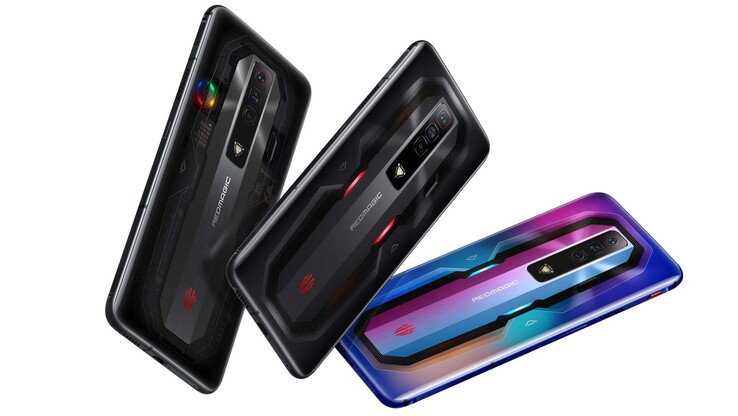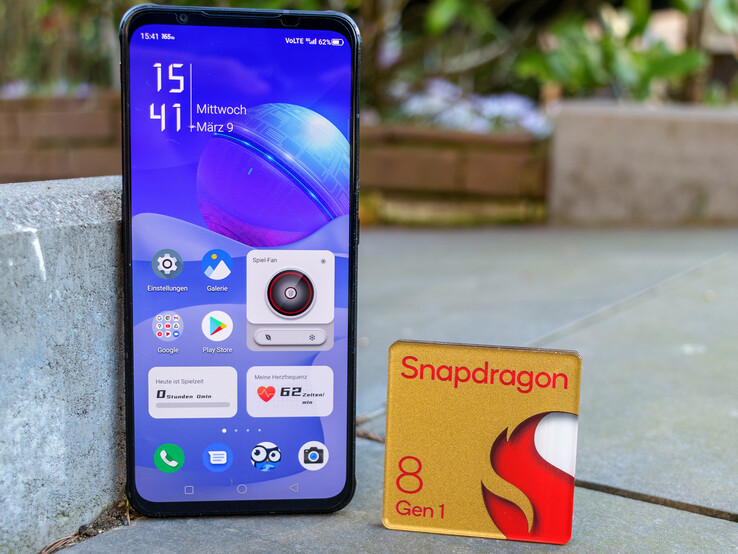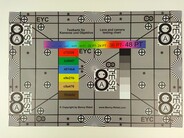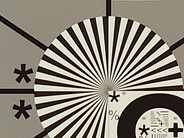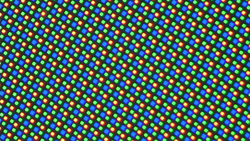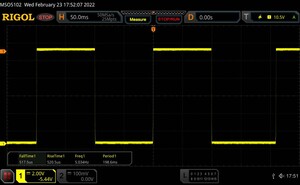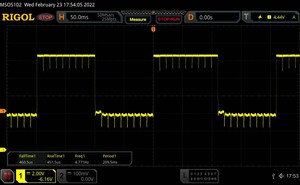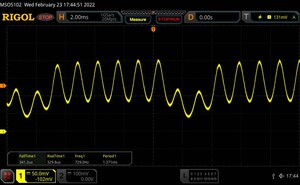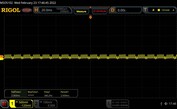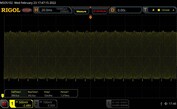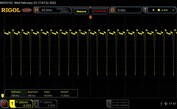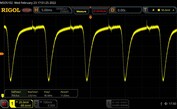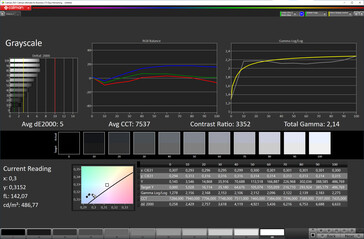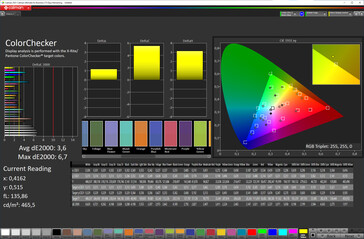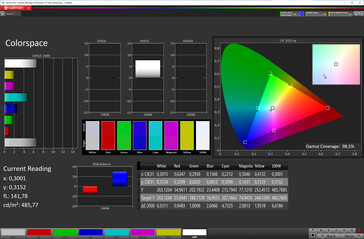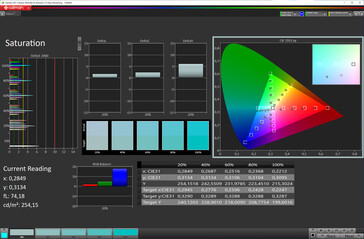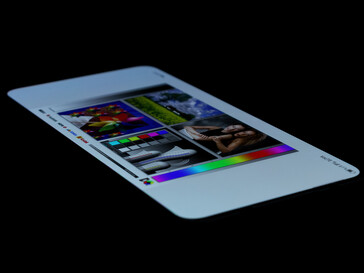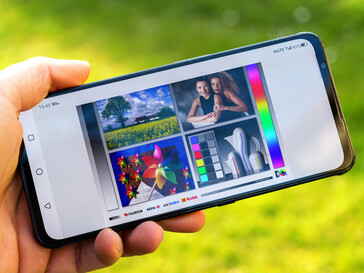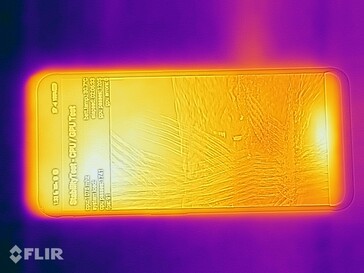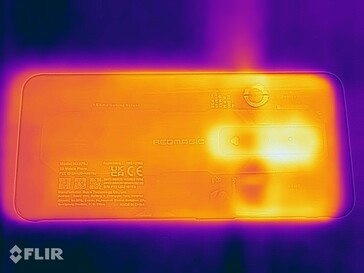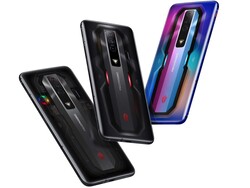Nubia RedMagic 7 review - Fast gaming phone with 165 Hz AMOLED and LED fan
Possible competitors in comparison
rating | date | model | weight | drive | size | resolution | price from |
|---|---|---|---|---|---|---|---|
| 85 % v7 (old) | 03 / 2022 | Nubia RedMagic 7 SD 8 Gen 1, Adreno 730 | 226 g | 256 GB UFS 3.1 Flash | 6.80" | 2400x1080 | |
| 83.6 % v7 (old) | 10 / 2021 | Nubia RedMagic 6S Pro SD 888+ 5G, Adreno 660 | 220 g | 128 GB UFS 3.1 Flash | 6.80" | 2400x1080 | |
| 88.7 % v7 (old) | 12 / 2021 | Asus ROG Phone 5s SD 888+ 5G, Adreno 660 | 238 g | 512 GB UFS 3.1 Flash | 6.78" | 2448x1080 | |
| 87.7 % v7 (old) | 04 / 2021 | Lenovo Legion Phone Duel 2 SD 888 5G, Adreno 660 | 259 g | 512 GB UFS 3.1 Flash | 6.92" | 2460x1080 |
Case and features - heavy gaming smartphone with cool looks
The Nubia RedMagic 7 leaves a very high-quality and robust impression, which is not least due to its high weight. Although the manufacturer puts it at 215 grams (~7.6 oz), it actually weighs 226 grams (~8.0 oz).
The gaming smartphone's build quality is good. It resists twisting attempts almost too silently. Only the gaps on the back between the glass and the aluminum frame are not always completely flush. The RedMagic is available in the tonal colors Pulsar (magenta-blue), Obsidian (gray) and Supernova. The latter is our review unit, which is primarily gray-black, but has a partially transparent back panel that reveals a view of the LED fan.
The RedMagic 7's equipment is completely focused on gaming. Thus, two shoulder sensors are again available as additional keys for gaming, which work with a sampling rate of 500 Hz and have a delay of 8 milliseconds. A so-called 4D vibration is also supported in selected titles, but the list for this is very short and identical to that of the predecessor RedMagic 6S Pro.
The USB-C port works according to the 2.0 specifications, but at least supports OTG. An audio jack is also installed and the gaming interface can be started or stopped with the distinctive red toggle switch.
Communication, software and operation
The Nubia RedMagic 7 is based on Google Android 12 with the in-house user interface RedMagic OS 5.0. The security patches were updated on January 1, 2022, at the time of our review and are thus still reasonably up-to-date. Nubia has so far remained silent about the duration of the update supply, but it recently started rolling out Android 12 for the predecessor, so Android 13 seems quite realistic for the gaming smartphone.
The RedMagic 7 has noticeably improved its mobile connectivity and can now use a broader frequency band portfolio. The Wi-Fi module is specified as Wi-Fi 6E, but the 6 GHz band provided by our reference router Asus ROG Rapture GT-AXE11000 is not recognized. The transmission rates are very constant when receiving data, but do not nearly exhaust the possibilities of Wi-Fi 6. When transmitting, the RedMagic is reproducibly very slow at the beginning and then gets faster, but higher data rates should be possible in this range as well. Hopefully, Nubia will improve this issue.
In terms of telephony, the RedMagic 7 shows an average performance. The voice quality is okay when held to the ear, but the suppression of ambient noise only works moderately. The speaker echoes minimally, but the microphones only have a short range. VoLTE and WLAN calling are supported.
The capacitive touchscreen responds very quickly to inputs, but the already applied protective film slightly inhibits the gliding properties. The two touch-sensitive sensors now have a slightly higher sampling rate and respond very reliably in the test.
An optical fingerprint sensor is already installed in the display for biometric security, which performs reliably and quickly. The heart rate can also be measured via the sensor. Additionally or alternatively, a less secure facial recognition via the front-facing camera is available.
| Networking | |
| iperf3 transmit AXE11000 | |
| Nubia RedMagic 7 | |
| iperf3 receive AXE11000 | |
| Nubia RedMagic 7 | |
| iperf3 transmit AX12 | |
| Nubia RedMagic 6S Pro | |
| Asus ROG Phone 5s | |
| Lenovo Legion Phone Duel 2 | |
| iperf3 receive AX12 | |
| Nubia RedMagic 6S Pro | |
| Asus ROG Phone 5s | |
| Lenovo Legion Phone Duel 2 | |
Cameras - RedMagic 7 with triple camera
The cameras of the Nubia RedMagic 7 have not changed compared to the predecessor. However, the software of the front-facing camera has obviously been revised because the pictures taken with it are now more coherent.
The triple camera again offers an ultra-wide-angle and a macro lens in addition to the 64 MP main sensor. Software adjustments can be seen here as well. The colors look more natural and the sharpness has been improved. However, the RedMagic still shows a rather weak dynamic range in backlight. The zoom (max. 10x, digital) is also not really convincing due to the visible aberrations.
Videos can even be recorded in 8k, but they are a bit jerky during panning
Image comparison
Choose a scene and navigate within the first image. One click changes the position on touchscreens. One click on the zoomed-in image opens the original in a new window. The first image shows the scaled photograph of the test device.
Main cameraMain cameraUltra wide angle5x ZoomLow-Light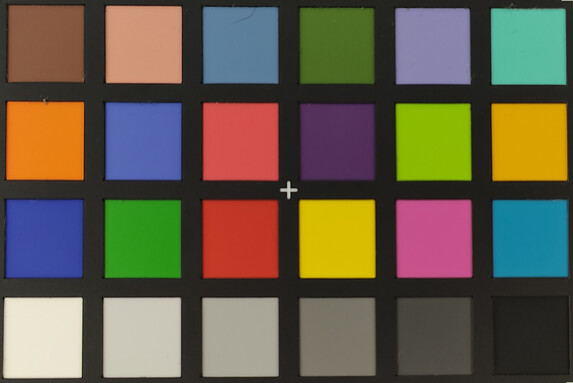

Display - Bright 165 Hz AMOLED
The AMOLED panel of the Nubia RedMagic 7 measures 6.8 inches and uses a Full HD Plus resolution. The high refresh rate of up to 165 Hz is certainly a highlight. The brightness remains just below the 700 cd/m² offered when the ambient light sensor is enabled, but it climbs up to 1,005 cd/m² in a measurement with evenly distributed bright and dark areas (APL50). Those who prefer to adjust the brightness manually have up to 491 cd/m² at their disposal.
The Nubia smartphone is also not spared from the flickering typical for OLEDs, which fluctuates with an uneven period between 243.5 and 729 Hz. When the brightness is set to 46% or higher, we measure a constant 90 Hz. The optional DC dimming mode also works with a refresh rate of a fixed 90 Hz.
The color reproduction is decent, but characterized by a cool display with strong colors. If you prefer a more natural picture, you can only counteract this minimally in the settings.
| |||||||||||||||||||||||||
Brightness Distribution: 95 %
Center on Battery: 683 cd/m²
Contrast: ∞:1 (Black: 0 cd/m²)
ΔE ColorChecker Calman: 3.6 | ∀{0.5-29.43 Ø4.77}
ΔE Greyscale Calman: 5 | ∀{0.09-98 Ø5}
98.5% sRGB (Calman 2D)
Gamma: 2.14
CCT: 7537 K
| Nubia RedMagic 7 AMOLED, 2400x1080, 6.8" | Nubia RedMagic 6S Pro AMOLED, 2400x1080, 6.8" | Asus ROG Phone 5s AMOLED, 2448x1080, 6.8" | Lenovo Legion Phone Duel 2 AMOLED, 2460x1080, 6.9" | |
|---|---|---|---|---|
| Response Times | -147% | -147% | -628% | |
| Response Time Grey 50% / Grey 80% * (ms) | 0.912 ? | 2.4 ? -163% | 2.4 ? -163% | 8 ? -777% |
| Response Time Black / White * (ms) | 1.038 ? | 2.4 ? -131% | 2.4 ? -131% | 6 ? -478% |
| PWM Frequency (Hz) | 729 | 90.6 ? | 575 ? | 568 |
| Screen | -20% | 34% | -4% | |
| Brightness middle (cd/m²) | 683 | 714 5% | 749 10% | 463 -32% |
| Brightness (cd/m²) | 685 | 705 3% | 750 9% | 466 -32% |
| Brightness Distribution (%) | 95 | 96 1% | 97 2% | 98 3% |
| Black Level * (cd/m²) | ||||
| Colorchecker dE 2000 * | 3.6 | 5.9 -64% | 1.4 61% | 3.24 10% |
| Colorchecker dE 2000 max. * | 6.7 | 8.7 -30% | 2.8 58% | 5.75 14% |
| Greyscale dE 2000 * | 5 | 6.8 -36% | 1.8 64% | 4.4 12% |
| Gamma | 2.14 103% | 2.25 98% | 2.29 96% | 2.201 100% |
| CCT | 7537 86% | 7774 84% | 6602 98% | 7273 89% |
| Total Average (Program / Settings) | -84% /
-52% | -57% /
-11% | -316% /
-160% |
* ... smaller is better
Display Response Times
| ↔ Response Time Black to White | ||
|---|---|---|
| 1.038 ms ... rise ↗ and fall ↘ combined | ↗ 0.521 ms rise | |
| ↘ 0.518 ms fall | ||
| The screen shows very fast response rates in our tests and should be very well suited for fast-paced gaming. In comparison, all tested devices range from 0.1 (minimum) to 240 (maximum) ms. » 4 % of all devices are better. This means that the measured response time is better than the average of all tested devices (20.2 ms). | ||
| ↔ Response Time 50% Grey to 80% Grey | ||
| 0.912 ms ... rise ↗ and fall ↘ combined | ↗ 0.452 ms rise | |
| ↘ 0.461 ms fall | ||
| The screen shows very fast response rates in our tests and should be very well suited for fast-paced gaming. In comparison, all tested devices range from 0.165 (minimum) to 636 (maximum) ms. » 3 % of all devices are better. This means that the measured response time is better than the average of all tested devices (31.6 ms). | ||
Screen Flickering / PWM (Pulse-Width Modulation)
| Screen flickering / PWM detected | 729 Hz | ||
The display backlight flickers at 729 Hz (worst case, e.g., utilizing PWM) . The frequency of 729 Hz is quite high, so most users sensitive to PWM should not notice any flickering. In comparison: 53 % of all tested devices do not use PWM to dim the display. If PWM was detected, an average of 8081 (minimum: 5 - maximum: 343500) Hz was measured. | |||
Performance, emissions and battery life
With the Snapdragon 8 Gen 1 and a full 18 GB of LPDDR5 working memory, the RedMagic 7 offers strong performance. The active cooling of the gaming smartphone primarily improves the long-term performance, as the 3DMark stress test shows, but it cannot completely prevent losses.
The fan also has a positive impact on the surface temperatures. While the Stability Test does not disturb the RedMagic even under permanent load, the 3DMark stress test Wild Life Extreme is more demanding and drives the values up to 44 °C (111.2 °F). When the fan is deactivated, these even rise to 55 °C (131 °F). The small fan works with up to 20,000 RPM and is quite loud (max. 45 dB(A)).
The two speakers deliver quite a good sound, provided they are not set too loud, in which case the trebles tend to overdrive. The audio jack (SNR: 86.10 dBFS) is also convincing and those who prefer to use Bluetooth have a wide audio codec support (SBC, AAC, aptX, aptX HD, aptX Adaptive, aptX TWS+, LDAC) at their disposal.
The 4,500 mAh battery provides good runtimes, although they could certainly be improved.
| Nubia RedMagic 7 | Nubia RedMagic 6S Pro | Asus ROG Phone 5s | Lenovo Legion Phone Duel 2 | Average 256 GB UFS 3.1 Flash | Average of class Smartphone | |
|---|---|---|---|---|---|---|
| AndroBench 3-5 | -16% | -7% | -12% | 1% | 24% | |
| Sequential Read 256KB (MB/s) | 1750 | 1607 -8% | 1972 13% | 1999 14% | 1757 ? 0% | 2246 ? 28% |
| Sequential Write 256KB (MB/s) | 1260 | 765 -39% | 770 -39% | 754 -40% | 1204 ? -4% | 1882 ? 49% |
| Random Read 4KB (MB/s) | 306.2 | 285.8 -7% | 297.8 -3% | 262.6 -14% | 287 ? -6% | 298 ? -3% |
| Random Write 4KB (MB/s) | 282.5 | 254.9 -10% | 287.2 2% | 261.5 -7% | 318 ? 13% | 346 ? 22% |
Temperature
(+) The maximum temperature on the upper side is 32.2 °C / 90 F, compared to the average of 35.2 °C / 95 F, ranging from 21.9 to 247 °C for the class Smartphone.
(+) The bottom heats up to a maximum of 32.2 °C / 90 F, compared to the average of 34 °C / 93 F
(+) In idle usage, the average temperature for the upper side is 28.6 °C / 83 F, compared to the device average of 32.9 °C / 91 F.
3DMark Stress Tests
Speaker
Nubia RedMagic 7 audio analysis
(+) | speakers can play relatively loud (91.8 dB)
Bass 100 - 315 Hz
(-) | nearly no bass - on average 21.9% lower than median
(+) | bass is linear (6.9% delta to prev. frequency)
Mids 400 - 2000 Hz
(±) | higher mids - on average 5.8% higher than median
(+) | mids are linear (4.5% delta to prev. frequency)
Highs 2 - 16 kHz
(±) | higher highs - on average 6.9% higher than median
(+) | highs are linear (4.8% delta to prev. frequency)
Overall 100 - 16.000 Hz
(±) | linearity of overall sound is average (18.9% difference to median)
Compared to same class
» 23% of all tested devices in this class were better, 10% similar, 67% worse
» The best had a delta of 11%, average was 35%, worst was 134%
Compared to all devices tested
» 43% of all tested devices were better, 8% similar, 49% worse
» The best had a delta of 4%, average was 24%, worst was 134%
Asus ROG Phone 5s audio analysis
(+) | speakers can play relatively loud (90.5 dB)
Bass 100 - 315 Hz
(-) | nearly no bass - on average 20.9% lower than median
(+) | bass is linear (6.2% delta to prev. frequency)
Mids 400 - 2000 Hz
(+) | balanced mids - only 3.3% away from median
(+) | mids are linear (4.8% delta to prev. frequency)
Highs 2 - 16 kHz
(+) | balanced highs - only 4.9% away from median
(+) | highs are linear (3.9% delta to prev. frequency)
Overall 100 - 16.000 Hz
(+) | overall sound is linear (14.9% difference to median)
Compared to same class
» 2% of all tested devices in this class were better, 2% similar, 96% worse
» The best had a delta of 11%, average was 35%, worst was 134%
Compared to all devices tested
» 19% of all tested devices were better, 4% similar, 76% worse
» The best had a delta of 4%, average was 24%, worst was 134%
Battery life
| Nubia RedMagic 7 4500 mAh | Nubia RedMagic 6S Pro 5050 mAh | Asus ROG Phone 5s 6000 mAh | Lenovo Legion Phone Duel 2 5500 mAh | Average of class Smartphone | |
|---|---|---|---|---|---|
| Battery Runtime | |||||
| WiFi Websurfing (h) | 11.1 | 13.8 24% | 12.2 10% | 15.1 36% | 19.3 ? 74% |
Pros
Cons
Verdict - Strong gamer with small weaknesses
Nubia has made some changes to the RedMagic 7. The latest addition to the gaming series is characterized by the current Snapdragon 8 Gen 1 which remains more stable than other smartphones with this SoC for a longer time due to its cooling system with active ventilation. In return, the user has to put up with a pretty loud fan.
The 165 Hz panel makes quite an impression on the spec sheet, but not even a handful of games support this refresh rate, and the 4D vibration is similar. The additional shoulder buttons are a real advantage when gaming and work great.
The Nubia RedMagic 7 offers a lot of gaming flair at a low entry-level price.
The smartphone has to put up with criticism due to the software support. HFR games are not very numerous for the RedMagic, and the update intervals are very rare and of unknown duration. The transmission speed in the WLAN was also low in the test.
Strong alternatives are the Asus ROG Phone 5s and the Lenovo Legion Phone 2 which, however, still have the predecessor's SoC.
Price and availability
The Nubia RedMagic 7 has an MSRP between 629 and 799 Euros (~$691 and ~$879), depending on the configuration. It can be purchased directly from the manufacturer's own online store at https://eu.redmagic.gg/de/products/redmagic-7 but is usually also available via Amazon.
Nubia RedMagic 7
- 08/30/2022 v7 (old)
Daniel Schmidt


